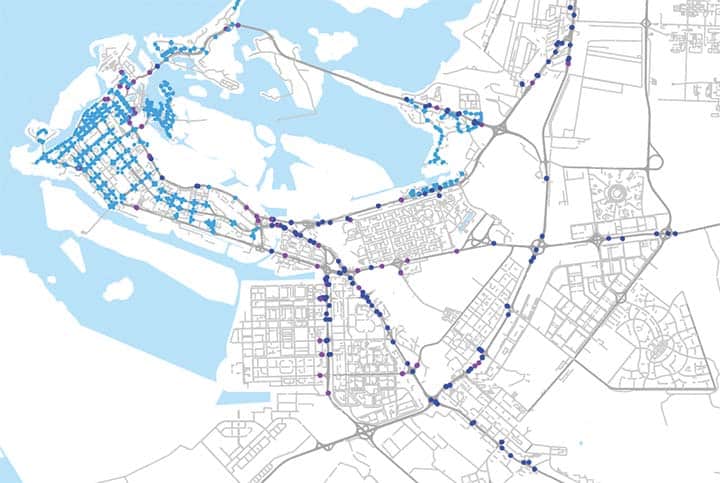Abu Dhabi’s integrated transport modelling framework
Published 3月 16, 2022
As reported in the latest issue of Infrastructure Magazine:
The availability of huge new datasets is driving rapid advancements in approaches to transport modelling for planning and operations.
At the Abu Dhabi Integrated Transport Centre (ITC), new data is being leveraged to update the existing Strategic Transportation Evaluation and Assessment Model (known by the acronym of STEAM) to STEAM+.
STEAM+ is a state-of-the-art, all-in- one transport modelling framework which integrates the existing strategic modelling approach with new hybrid dynamic models and near-real-time transport simulation from Aimsun.
The STEAM+ model was recently recognised for innovation in multimodal transport demand forecasting when it won the award for Best Transport Planning Management System at the 2021 Global Economics Awards.
The award-winning framework allows assessment of any type of transport scheme, ranging from specific intersections to large infrastructure studies, transit corridors and policy tests.
In addition, the multi-tiered STEAM+ framework complements the current regional strategic model with more detailed, dynamic assessment of flow metering at junctions, traffic queuing, ITS and emerging technologies, bus priority schemes and light rail (LRT) delays at junctions.
Big data
Abu Dhabi ITC is linking big datasets, including day-to-day anonymized mobile phone tracking, water/ electricity consumption by household, live bus and taxi fleets, building and plot level municipal data, as well as a comprehensive population and employment data set.
This is a hugely ambitious project on a never-before-attempted scale, covering the entire Abu Dhabi Emirate. In terms of scale, the model covers an area spanning 67,000 square kilometers with a population of approximately three million people.
The area has a hugely diverse range of infrastructure and development, from rural highways and towns, to mid-sized inland cities such
as Al Ain, and, of course, the Emirate capital of Abu Dhabi with its densely populated central business district.
ITC required a transport model framework with multiple levels of assignment and simulation that is flexible and extensible enough to accommodate future needs.
The hybrid simulation model
Set up by the Aimsun team, the Hybrid Simulation Model will enhance ITC’s modeling capabilities, adding a tiered simulation model alongside the strategic demand model within the STEAM+ framework.
The Hybrid Simulation Model allows rapid simulation of specific network areas, and accurate representation of congestion, flow metering, ITC’s technology interventions, bus priority assessment and LRT delays at junctions.
Additionally, dynamic linkages to the ITC Data Warehouse will allow rapid modeling of specific days based on the latest count and movement data.
Integrating hybrid simulation with static models
The framework takes an integrated approach, which offers major advantages in speed and consistency when compared with creation of independent local networks in multiple software packages.
The coded network allows rapid development of local area simulations within the same software platform, using a single network representation, together with consistent simulated travel behaviour and routing.
The Aimsun team set up and calibrated the model network, demand model linkages, and dynamic linkages to the Data Warehouse. The highly detailed transport network was derived from the comprehensive Navigable Road Network (NRN) dataset.
This representation of the transport infrastructure was further refined using aerial imagery and CAD, and then supplemented with detailed information on traffic signal operations. Using detailed data provided by the Traffic Management Centre, the Aimsun team coded explicit representations of the traffic signal control cycles, and the variation in plans for different days and types of day into the model.
The consistency with, and linkage to, the demand model, ensures transferability of information between models and avoids competing and potentially conflicting representations and outputs. Aimsun processes allowed a data-driven derivation of different demand patterns for different types of day.
Inventive use of automation procedures and scripting enabled processing of this quantity of information and maintenance of close linkages to the demand model. The Hybrid Simulation Model is dynamically linked to the ITC’s newly developed Data Warehouse.
This dynamic link allows fresh count data and trip origin-destination data to be input directly into the model for simulation. Results are evaluated by automatic validation plots.

How transport modelling benefits Abu Dhabi
The Hybrid Simulation Model within STEAM+ provides ITC with a framework for testing schemes and interventions with the appropriate level of detail within much reduced timeframes and with a consistent model representation.
Another benefit is visualisation of the road traffic, which is key for communicating results to stakeholders and the general public. The dynamic link between the model and the Data Warehouse allows accurate simulation of specific days or special periods, such as Ramadan.
It also simplifies model updates and transfer of detailed information from the Hybrid Simulation Model to the Demand Model.
Looking to the future
Ongoing support is included in the solution to ensure successful knowledge handover and plan the future road map for the model framework.
A close working relationship between Aimsun, Abu Dhabi ITC, and other stakeholders ensures that the best use continues to be made of the wide range of datasets available, and that modeling processes are efficient, repeatable, and easy to update.


